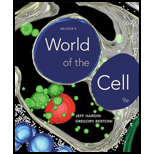
Concept explainers
(a)
To determine: The name and chemical formula of charged form of ammonia.
Introduction: Most of the solutes that are present in the cytosolic system and that move into and out of the cell exist in either an ionized form or protonated form. These forms also possess protonated or ionized
(b)
To determine: The form among protonated and ionized forms that will predominate in a solution with a high acidic pH.
Introduction: Most of the solutes that are present in the cytosolic system and that move into and out of the cell exist in either an ionized form or protonated form. These forms also possess protonated or ionized functional groups which help in the transport of various substances in and out of the plasma membrane.
(c)
To determine: The form among protonated and ionized forms for which uptake across cell membrane be affected by the concentration gradient of respective forms on inside and outside of cells. Also, determine that uptake of which form is affected by the membrane potential of the plasma membrane.
Introduction: Most of the solutes that are present in the cytosolic system and that move into and out of the cell exist in either an ionized form or protonated form. These forms also possess protonated or ionized functional groups which help in the transport of various substances in and out of the plasma membrane.
(d)
To determine: Whether or not uptake of charged form require more or less energy as compared to uptake of uncharged form in case of ammonia.
Introduction: Most of the solutes that are present in the cytosolic system and that move into and out of the cell exist in either an ionized form or protonated form. These forms also possess protonated or ionized functional groups which help in the transport of various substances in and out of the plasma membrane.
(e)
To determine: The charged form in case of acetic acid. Also, determine the form among protonated and ionized forms for which uptake across cell membrane be affected by concentration gradient of respective forms on inside and outside of cells. Also, determine that uptake of which form is affected by membrane potential of the plasma membrane.
Introduction: Most of the solutes that are present in cytosolic system and that move into and out of the cell exist in either an ionized form or protonated form. These forms also possess protonated or ionized functional groups which help in the transport of various substances in and out of the plasma membrane.
(f)
To determine: Whether or not, in case of cells that take up acetic acid from the environment, uptake of charged form require more or less energy as compared to uptake of uncharged form
Introduction: Most of the solutes that are present in the cytosolic system and that move into and out of the cell exist in either an ionized form or protonated form. These forms also possess protonated or ionized functional groups which help in the transport of various substances in and out of the plasma membrane.
Want to see the full answer?
Check out a sample textbook solution
Chapter 8 Solutions
Becker's World of the Cell (9th Edition)
- In one paragraph show how atoms and they're structure are related to the structure of dna and proteins. Talk about what atoms are. what they're made of, why chemical bonding is important to DNA?arrow_forwardWhat are the structure and properties of atoms and chemical bonds (especially how they relate to DNA and proteins).arrow_forwardThe Sentinel Cell: Nature’s Answer to Cancer?arrow_forward
- Molecular Biology Question You are working to characterize a novel protein in mice. Analysis shows that high levels of the primary transcript that codes for this protein are found in tissue from the brain, muscle, liver, and pancreas. However, an antibody that recognizes the C-terminal portion of the protein indicates that the protein is present in brain, muscle, and liver, but not in the pancreas. What is the most likely explanation for this result?arrow_forwardMolecular Biology Explain/discuss how “slow stop” and “quick/fast stop” mutants wereused to identify different protein involved in DNA replication in E. coli.arrow_forwardMolecular Biology Question A gene that codes for a protein was removed from a eukaryotic cell and inserted into a prokaryotic cell. Although the gene was successfully transcribed and translated, it produced a different protein than it produced in the eukaryotic cell. What is the most likely explanation?arrow_forward
- Molecular Biology LIST three characteristics of origins of replicationarrow_forwardMolecular Biology Question Please help. Thank you For E coli DNA polymerase III, give the structure and function of the b-clamp sub-complex. Describe how the structure of this sub-complex is important for it’s function.arrow_forwardMolecular Biology LIST three characteristics of DNA Polymerasesarrow_forward
 Biology (MindTap Course List)BiologyISBN:9781337392938Author:Eldra Solomon, Charles Martin, Diana W. Martin, Linda R. BergPublisher:Cengage Learning
Biology (MindTap Course List)BiologyISBN:9781337392938Author:Eldra Solomon, Charles Martin, Diana W. Martin, Linda R. BergPublisher:Cengage Learning Biology Today and Tomorrow without Physiology (Mi...BiologyISBN:9781305117396Author:Cecie Starr, Christine Evers, Lisa StarrPublisher:Cengage Learning
Biology Today and Tomorrow without Physiology (Mi...BiologyISBN:9781305117396Author:Cecie Starr, Christine Evers, Lisa StarrPublisher:Cengage Learning
 Biology 2eBiologyISBN:9781947172517Author:Matthew Douglas, Jung Choi, Mary Ann ClarkPublisher:OpenStax
Biology 2eBiologyISBN:9781947172517Author:Matthew Douglas, Jung Choi, Mary Ann ClarkPublisher:OpenStax





